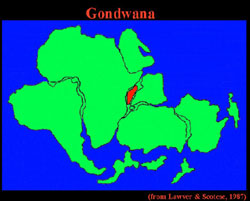 |
QUICK SEARCH
MO PROJECTS:
Africa
Asia/Pacific
Mesoamerica
North America
South America
General Taxonomy
Photo Essays
Training in Latin
America
MO RESEARCH:
Wm. L. Brown Center
Bryology
GIS
Graduate Studies
Research Experiences
for Undergraduates
Imaging Lab
Library
MBG Press
Publications
Climate Change
Catalog Fossil Plants
MO DATABASES:
W³MOST
Image Index
Rare Books
Angiosperm
Phylogeny
Res Botanica
All Databases
INFORMATION:
What's New?
People at MO
Visitor's Guide
Herbarium
Jobs & Fellowships
Symposium
Research Links
Site Map
Search
Malagasy/Indo-australo-malesian Phytogeographic ConnectionsLong Distance Dispersal | Conclusion | References INTRODUCTION As a former piece of the African continent that has remained in close proximity throughout its evolutionary history, Madagascar would reasonably be expected to possess a biota whose closest affinities are African. Recognition therefore of phytogeographic connections with floras far to the east has attracted the interest of botanists since the classic work of Perrier de la Bâthie (1936). Subsequent workers have adopted and refined the characterization of floristic affinities by percentage generic overlap within arbitrarily delimited geographic units ("elements"), among which "Asian", "oriental", "paleotropical", and "austral" have been utilized to reflect the eastern affinities (Humbert 1959; Koechlin et al. 1972; Dejardin et al. 1973). However, as Leroy (1978) correctly pointed out, such analyses of relationship depend upon taxonomic circumscription of genera rather than phylogenetic hypotheses, and fail to address process in historical biogeography. The distinction made by Aubréville (1976) between "Australo-Papoue" as Gondwanan elements and "Asiatico-Malesienne" as Laurasian elements set the stage for a more explicit discussion of the historical patterns leading to modern-day relationships between the floras of Madagascar and Indo-australo-malesia. In that context, utilizing data from recent phylogenetic, paleobotanical, and paleogeographic studies, I would like to illuminate further what I believe to be the three major modes of dispersal/vicariance between Madagascar and lands to the east: 1) Cretaceous Gondwanan Relicts; 2) Eocene-Oligocene "Lemurian Stepping-stones"; and 3) Long Distance Dispersal (LDD).

|
© 1995-2024 Missouri Botanical Garden, All Rights Reserved
4344 Shaw Blvd.
St. Louis, MO 63110
(314) 577-5100
Technical Support